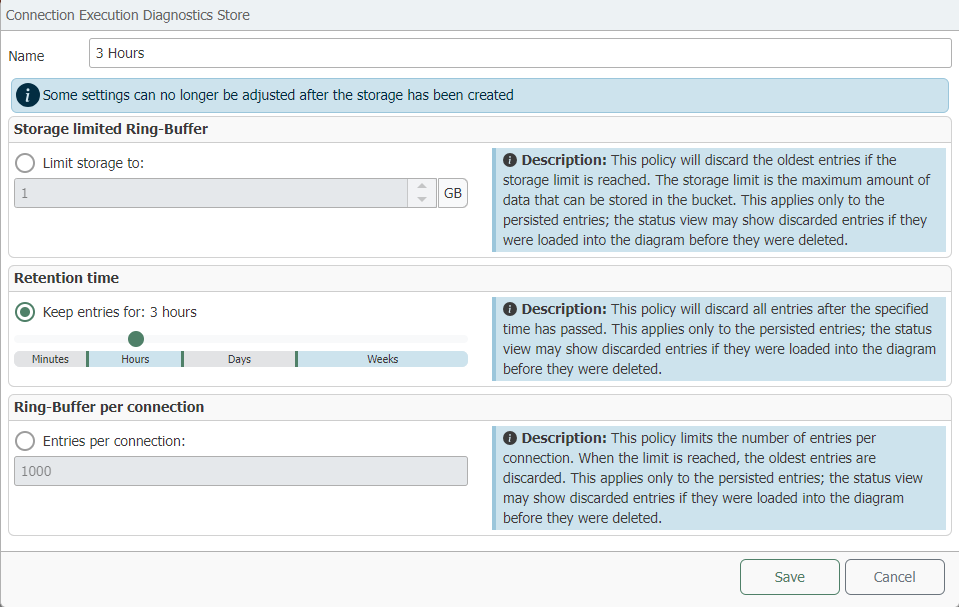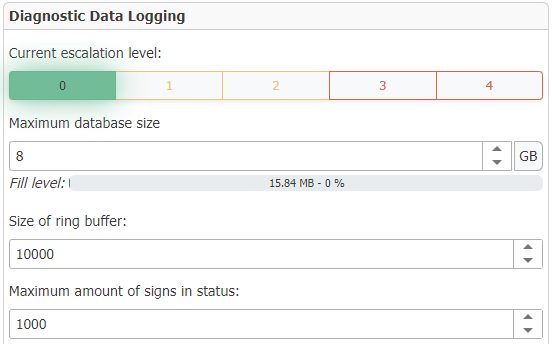Status storage options
Connection Execution Diagnostics Storages
New diagnostic storages for connection execution can be created here. The values that are transmitted in a connection are saved in these diagnostic storages. The storad values are being displayed when you click on a point in the status chart of a connection.
Preconfigured Connection Execution Diagnostics Storages

Diagnostic Storages overview
| Rollover 4GB (default) | Saves a maximum of 4 GB of data. When the limit is reached old data is being overwritten |
| Max10Entries | Saves at most values from the last 10 executions per connection. |
| 3 Days | Saves data for 3 days. Older data is being deleted. |
| Discard | No data is being saved. Discard is well suited if no storage of the transferred data is required. This can save memory space. |
Overview of the diagnostic memory for connection execution
The diagnostic memories are listed in a clear table.
On the left-hand side of each row, there are buttons for editing, deleting and duplicating the diagnostic memories. The star button can be used to set a diagnostic memory as the default. You can find out how these memories can be used for connections here: settings-for-connections-and-templates.md.
Create a Connection Execution Diagnostics Storage

Creating a new Diagnostics Storage
The following properties can be configured for a Diagnostics Storage:
| Name | The name for the diagnostics storage. It is used to identify the Diagnostics Storage when projecting. |
| Type of limitation | Storage limited Ring-Buffer: The amount of data that is stored before data is overwritten can be specified here. |
After creation, the newly created storage is displayed in the overview.
Diagnostic Data Logging
Here you can conveniently see what the current escalation level is.
For more information see: Escalation levels

Diagnostic Data Loggin with current escalation level
The following options can be configured for Diagnostic Data Logging
| Maximum database size | The maximum amount of data in GB that can be stored. |
| Size of ring buffer | The maximum number of entries in the ring buffer. Default value: 2000 entries. |
| Maximum amound of characters in the status | The maximum number of characters that are saved for a value in the status display. |
Transfer execution diagnostics
Here you can configure which transfer execution diagnostic data should be recorded and how much of it should be stored.
The following data can be recorded:
| Notifications | History of sent notifications. Default value: 512 MB. |
| Connection status | The status history of connections. e.g. "Ready" or "Plug-in Error". |
| Plug-in status | The status history of plug-ins. e.g. "Ready" or "Error". |
Diagnosis of the runtime service
Here you can configure which runtime service diagnostic data should be recorded and how much of it should be stored.
The following data can be recorded:
| Service Events | History of Service Events. Default value: 256 MB. |
| Service Status | Status history of the runtime service. Default value: 256 MB. |
| Service Health | Health of the runtime service. Default value: 256 MB. |
| Performance metrics | Data on the performance of the OPC Router. Default value: 256 MB. |
If enough data is available, an estimated recording rate and recording time are being shown for the diagnostic data of the transmission execution and the runtime service. This can look like this, for example:

Data recording estimates
Approximately 3.46 MB of data is being recorded per hour. This means that the data can be stored for approximately 3 days before it is being overwritten.